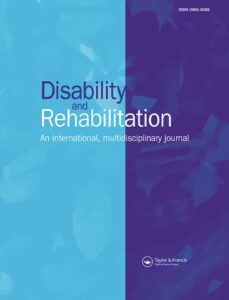Publications

Effect of virtual walking on chronic pain, tone and spasticity in incomplete spinal cord injury
Authors: Sara Molla-Casanova 1, Elena Munoz-Gomez 1, Nuria Sempere-Rubio 1, Noemi Moreno-Segura 1, Marta Ingles 1, Luis-Millan Gonzalez 2, Pilar Serra-Ano 1
Affiliations:
- UbiC Research Group, Department of Physiotherapy, Faculty of Physiotherapy, University of Valencia, Valencia, Spain
- Department of Physical Education and Sport, University of Valencia, Valencia, Spain
Journal: Disability and Rehabilitation - November 2025 (DOI: 10.1080/09638288.2025.2583905)
-
Field & Applications:
- Medical
- Treatment evaluation
- Musculoskeletal rehabilitation
- Physiotherapy
- Recovery from injury
Purpose: To assess the effect of combining virtual walking (VW) with physical exercise (PE) compared to PE alone in people with incomplete spinal cord injury (iSCI).
Methods: A randomised controlled trial was designed. Thirty-eight people with iSCI performed 18 sessions (6 weeks) according to assigned group: i. Experimental Intervention (EI): VW with PE; or ii. Control intervention (CI): Placebo VW with PE. Chronic pain, muscle tone, and spasticity were assessed at baseline (T1), after the intervention (T2) and at 4 (T3) and 12 weeks (T4) follow-up.
Results: The EI group exhibited a decrease in pain severity at T2 (p = 0.02), and a reduction in interference with mood and walking at T2 (p = 0.02 and p = 0.04). In the CI group, pain interference with mood and work decreased at T3 (p = 0.03 and p = 0.04). For spasticity, the EI group showed a reduction at T2 (p = 0.02), T3 (p = 0.01) and T4 (p = 0.03) compared to T1, whereas the CI group only showed a decrease at T3 (p = 0.02) compared to T1. No changes were found in tone at rest.
Conclusions: Combined use of VW and PE is effective in the short term in reducing pain and spasticity, unlike the application of PE alone, in individuals with iSCI. However, this intervention is not effective for improving muscle tone.
IMPLICATIONS FOR REHABILITATION
- A 6-week protocol of virtual walking combined with physical exercise may lead to an improvement in functional mobility and overall quality of life for individuals with incomplete spinal cord injury.
- This intervention does not significantly improve muscle tone at rest, indicating that its clinical benefits are limited to dynamic or functional contexts rather than passive muscle properties.
Keywords: spinal cord injury, virtual walking, pain, tone, spasticity
The combination of VW and PE is effective in the short term in reducing triceps surae spasticity, pain severity and its interference on mood and walk task, unlike the application of a PE programme alone, in individuals with incomplete SCI. However, this intervention is not effective for improving muscle tone measured at rest.


